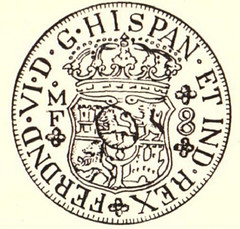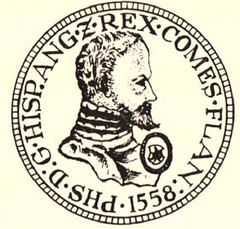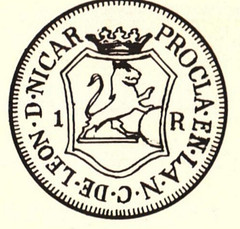
PREV ARTICLE
NEXT ARTICLE
FULL ISSUE
PREV FULL ISSUE
THE CASE OF THE LION COUNTERMARK
Numismatic research requires detective work. The March 1953 issue of The Numismatist from the American Numismatic Association
included an article invoking the fictional detective Sherlock Holmes to examine a mystery of the mis-attribution of three coins in the
1914 book El Duro by Adolfo Herrera. The article was republished April 23. 2016 on Greg Ruby's blog The Fourth Garrideb -
Numismatics of Sherlock Holmes. -Editor
(Sherlock holds in one hand a registered package that has been opened and in the other hand, a large 8 reales silver coin of the Mexico mint countermarked with a very aristocratic looking lion rampant. ) SHERLOCK: Watson, for the first time, we have at last a “corpus delicti” which we may examine minutely at our leisure and which will give us a definite clue to this most interesting and extremely puzzling case. I am confident however that this coin never saw the sunshine of Nicaragua in spite of what both Heiss, Herera and others say about it. In the first place, why should anyone place another “Spanish” royal lion where two honest-to-goodness royal “Spanish” lions are already ramping their way in the ether towards the west? The coin is already legal tender and how could another royal SPANISH (?) lion add to its reliability and acceptability in Nicaragua? Hand me my magnifying glass so that I can examine that intruder more minutely. . . Why, Watson, this does not look like a Spanish lion! It looks to me like one of those lions with a slick glossy coat and curling mane and a tail with its tassel curved backward and not forward as in the case of its two Spanish companions — just like those lions that roamed around in the marshes of the Low Countries! Yes, very much like that Brabant lion in an oval countermark on that silver crown of
WATSON: Yes, remarkably like that old 16th century countermark, but, Sherlock, the “dos Mundos” is an 18th century coin? SHERLOCK: I do not think that any colonial die sinker could have modeled such a well engraved lion. Of course, the two Gils of the Mexican Mint could have had a hand in it as they were about the best colonial engravers that Spain ever sent to her far-away colonial mints. No, Watson, unless they were taking a vacation, they never would have left the Mexican mint even for a couple of months as there was no mint in Nicaragua at that time and what enjoyment would there be for a master engraver like Gil to spend a vacation where there was no mint in which he could wander around. You know, Watson, even an old master may sometimes be a victim of mistaken judgment and of excessive enthusiasm. Take Herera, that grand old man. In his El Duro he ascribed three duros to a non-existing Nicaragua mint, coins which, I believe, are now recognized as being of South and not of Central American provenance and their NR is not NICA-RAGUA but Nuevo Reino! Could he not have been mistaken when, following Heiss, he ascribed the lion duro to Nicaragua? WATSON: But, Sherlock, was there not a medal or token struck for but probably not in Leon, Nicaragua, which shows clearly a lion rampant on the reverse?
WATSON: But, Sherlock, how does this help us? We have not yet solved the problem of where the coin does come from.
The rest of the story can be read online, and ANA members can find the original 1953 article in the Numismatist archive. -Editor
To read the complete article, see:
Wayne Homren, Editor The Numismatic Bibliomania Society is a non-profit organization promoting numismatic literature. See our web site at coinbooks.org. To submit items for publication in The E-Sylum, write to the Editor at this address: whomren@gmail.com To subscribe go to: https://my.binhost.com/lists/listinfo/esylum All Rights Reserved. NBS Home Page Contact the NBS webmaster 
|


